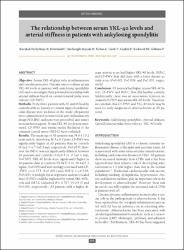The relationship between serum YKL-40 levels and arterial stiffness in patients with ankylosing spondylitis

View/
Access
info:eu-repo/semantics/openAccessDate
2017Author
Türkyılmaz, Ayşegül KüçükaliDevrimsel, Gül
Beyazal, Münevver Serdaroğlu
Kırbaş, Aynur
Çiçek, Yüksel Gülen
Çapkın, Erhan
Karkucak, Murat
Gökmen, Ferhat
Metadata
Show full item recordCitation
Kucukali Turkyilmaz, A., Devrimsel, G., Serdaroglu Beyazal, M., Kirbas, A., Cicek, Y., Capkin, E., Karkucak, M., & Gokmen, F. (2017). The relationship between serum YKL-40 levels and arterial stiffness in patients with ankylosing spondylitis. The relationship between serum YKL-40 levels and arterial stiffness in patients with ankylosing spondylitis. Acta reumatologica portuguesa, 42(2), 183–190.Abstract
Objective: Serum YKL-40 plays roles in inflammatory and vascular processes. Our aim was to evaluate serum YKL-40 levels in patients with ankylosing spondylitis (AS) and to investigate their potential relationship with arterial stiffness based on carotid-femoral pulse wave velocity (CF-PWV). Methods: Forty-three patients with AS and 41 healthy controls with no history or current signs of cardiovascular disease were included in the study. All patients were administered nonsteroidal anti-inflammatory drugs (NSAIDs), and none were prescribed anti-tumor necrosis factor agents. Serum YKL-40 levels were measured. CF-PWV and intima-media thickness of the common carotid artery (IMT-C) were evaluated. Results: the mean age of AS patients was 34.6 +/- 10.2 years and of controls was36.3 +/- 9.0 years. CF-PWV was significantly higher in AS patients than in controls (8.2 +/- 2.7 vs. 7.0 +/- 1.6 m/s, respectively; P=0.015). However, the IMT-C was not significantly different between AS patients and controls (0.6 +/- 0.3 vs. 0.5 +/- 0.2 mm, P=0.501). YKL-40 levels were significantly higher in AS patients than in controls (78.9 +/- 37.9 vs. 58.4 +/- 21.2 ng/mL, P=0.003) and were strongly correlated with CF-PWV (r=0.773, P<0.001) and IMT-C (r=0.548, P<0.001). A multiple linear regression analysis revealed that CF-PWV could be explained by serum YKL-40 levels and IMT-C (adjusted R-2 = 0.707, P=0.013 and P=0.001, respectively). AS patients with a higher disease activity score had higher YKL-40 levels, IMT-C, and CF-PWV than did those with a lower disease activity score (P<0.001, P=0.008, and P<0.001, respectively) Conclusion: AS patients had higher serum YKL-40 levels, CF-PWV, and IMT-C than did healthy controls. Additionally, there was an association between increased CF-PWV and serum YKL-40 levels. Therefore, we conclude that CF-PWV and YKL-40 levels may be used for early diagnosis of atherosclerosis in AS patients.

















